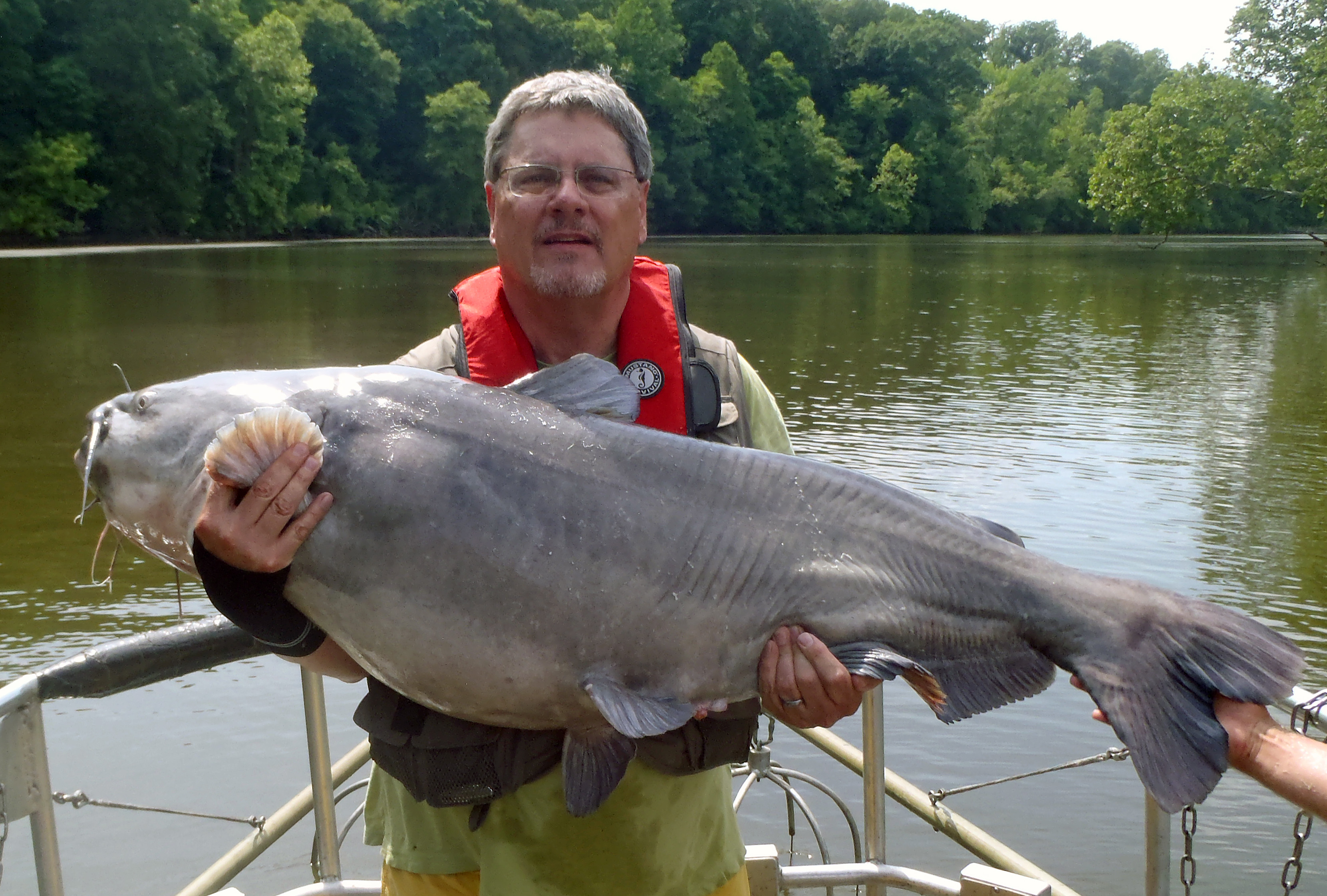Blue Catfish on the Move
With record rainfall and freshwater surges into tributaries of the Bay, it is easier than ever for blue catfish to enter new territory. They are turning up in high numbers in the James, Potomac, and small tributaries all over the watershed, including formerly high-salinity areas that are now awash with rainwater.

Researcher Don Orth and a huge catfish catch. Credit: Orth
Once a fun, 40-lb catch for an angler, the blue catfish is now overly abundant and growing smaller. Blue catfish were introduced to the Bay in the 1970’s to support sport fishing, when thousands of the Mississippi River natives were brought into the Rappahannock and James Rivers.
But the nutrient-rich tidal waters of the Bay provide a habitat that is almost too good for the blue catfish, allowing them to become very abundant and navigating into tributaries where they have not been previously recorded. Scientists are working to measure the impacts of all of these blue catfish, namely what they are eating and why it matters.
Understanding the blue catfish diet
Don Orth, Professor at Virginia Tech, has been studying fish management for years and has recently published several papers on blue catfish, including one published in 2017. His team sampled over 16,000 blue catfish stomachs from the James, Pamunkey, Mattaponi, and Rappahannock Rivers and saw that catfish have extremely broad diets including vegetation, detritus, mammals, birds, reptiles, fish, crustaceans, and other invertebrates.

A blue catfish with a recent blue crab snack. Credit: Orth
Managers and scientists are worried that these catfish will hurt endangered populations, but Orth found that “at-risk species are rarely consumed,” although they do eat a lot of blue crabs in the fall and winter. He found that the blue catfish diet is strongly correlated with season, salinity, and size of the fish, where larger fish tended to eat more at-risk species.
In another 2017 study, Orth’s team used a DNA barcoding technique to identify species eaten by blue catfish and flathead catfish, and found that blue catfish are not eating a lot of herring and shad – in fact, flathead catfish eat three times more migrating river herring and shad than blue catfish.
In 2019, the team modeled their blue catfish data and determined that catfish should be closely monitored in meso-haline zones, like the lower James, where they are likely to eat blue crabs. “If they are going to take away from crab harvests, that is where it is going to happen,” said Orth.
Blue catfish in the ecosystem
If they are not a major cause for concern for most at-risk species, how are these abundant fish affecting their ecosystem? Orth thinks they will continue to adapt as opportunistic omnivores. “When you think about the entire Bay, each one of these river systems is different in terms of salinity, depth, length, degree of nutrient input,” making it hard to draw broad conclusions.
Researchers have wondered if the decline in American shad was related to the boom of blue catfish, but Orth notes that American shad were in decline before catfish arrived in the Bay. Managers must figure out how to restore American shad now that catfish are here to stay.
Catfish for sale

Scientists from Virginia Tech try to net the large numbers of James River Blue Catfish surfacing during an electrofishing survey in 2015. Credit: Jason Emmel.
With so many available in the Bay, one solution could be that people should simply eat more catfish. “But no one knows how many blue catfish would need to be caught to reduce potential conflicts with other species – or whether a market exists for that large a catch,” reported the Bay Journal.
In a provision of the 2008 Farm Bill, USDA inspectors have to be on site when handling catfish, creating a significant barrier for small processing facilities. Many politicians are proponents of the provision because they are looking to support their constituents’ farmed catfish markets.
In addition, catfish are labor-intensive and produce less meat than striped bass or tuna, bottlenecking production. It would take large investments in processing facilities in order to make it worth it to increase catches. Additionally, large blue catfish have been found to have elevated levels of heavy metals, including mercury, posing a potential human health risk.
On top of all of these barriers, there just is not a lot of demand for catfish. “Catfish has always been a lower-valued product in the US,” explained Orth. It is perceived as a fishy-tasting, bottom-dwelling filet, and little effort has been put into its marketing.
“The management objectives are unclear”
While research on the effects of blue catfish has been underway, the Bay lacks a clear strategy for how to handle all the fish: “We have increased our knowledge in the past 20 years substantially,” said Orth, “the problem is, we have not worked to get agreed-upon management objectives.”
He noted that there are many stakeholders with different opinions on how to move forward, and there needs to be conflict resolution in order to find a strategy that works for all parties. “Until we have clear objectives, we will not make any progress,” added Orth.
In the meantime, Orth and colleagues Corbin Hilling and Dr. Yan Jiao are working on a population model of the catfish. He hopes to use it to test different management interventions and calculate the effects of consumption on blue crabs or other target species. “I always do my work in the management context, that can be used by managers.”
He and many others are optimistic about the Chesapeake Bay Program Invasive Catfish Workgroup. Orth is hopeful that the group will identify research goals for him and other scientists. “That’s exactly what we need – some kind of interstate group with enough stakeholders so we can have these conversations and objectives.”
